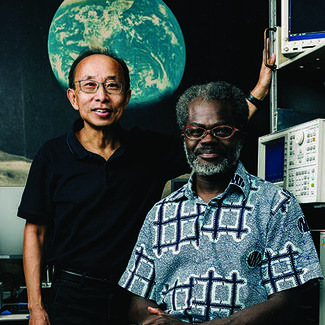
Kwabena Boahen and H.-S. Philip Wong’s nanodendrite
Do nerve cells hold the key to an epic advance in computing?
Professors Kwabena Boahen and H.-S. Philip Wong have built a nanodendrite, along with graduate students Matthew Beauchamp and Hugo Chen. Their hope is to create a chip that is efficient in both use of energy and delivery of information. Thus the nanodendrite.
The nanodendrite is the product of neuromorphic computing — that is, designing computer hardware and software to function like the brain. It’s a burgeoning field, driven largely by a desire to keep up with the computing demands of AI and reduce the massive amounts of energy it consumes. Technology companies such as IBM, Intel and HP, as well as a number of universities, have invested time and money to develop neuromorphic microchips.
Kwabena is one of the field’s pioneers. He designed his first neuromorphic chip as an undergraduate in the 1980s. After joining the faculty at Stanford in 2006, he proposed Neurogrid, a circuit board that would simulate 1 million neurons with 6 billion synapses, the structures where signals are passed between neurons.
His lab, Brains in Silicon, completed the project in 2010 and reported on it in 2014 in Proceedings of the Institute of Electrical and Electronics Engineers. Kwabena and his co-authors noted that Neurogrid was about 100,000 times as energy efficient as a conventional computer’s simulation of 1 million neurons. Yet they also noted that a human brain, with 80,000 times as many neurons, needs only three times as much power. Boahen hopes the nanodendrite will help bridge that gap. […]
Kwabena designed the tiny transistor with Professor H.-S. Philip Wong and graduate students Matthew Beauchamp and Hugo Chen.
Hugo Chen will present an experimental proof-of-concept paper that illustrates the operation of the nanodendrite in December at the International Electron Devices Meeting, the major forum for reporting advances in semiconductor and electronic device technology.
“From a device-technology point of view, there are many unanswered questions,” states Philip, who directs the Stanford Nanofabrication Facility. One such question is how to build nanodendrites in three dimensions — that is, stacked on top of each other in a single silicon chip. “Yet, I don’t believe those unanswered questions present any fundamental roadblocks,” he added. “It would take some innovative research ideas to find solutions, but I am optimistic that we will get there.”
Kwabena is also optimistic. Such a technology, were it available now, could cut GPT’s signals 400-fold, with an equivalent decrease in energy consumption. He concedes the work is in its early stages, with an actual dendrocentric computer chip probably about a decade away from realization.
“But once you see it, you can’t unsee it,” says Kwabena.
Excerpted from “Mind in the machine,” by John Sanford, Stanford Medicine, November 10, 2023